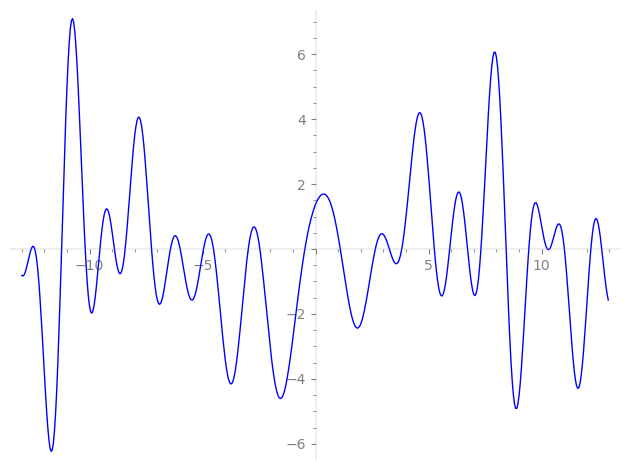| L(s) = 1 | + (0.5 + 0.866i)2-s + (−0.499 + 0.866i)4-s + (1.18 − 2.05i)5-s + (−4.22 + 2.43i)7-s − 0.999·8-s + 2.36·10-s + (−3.26 + 1.88i)11-s + (0.883 + 0.510i)13-s + (−4.22 − 2.43i)14-s + (−0.5 − 0.866i)16-s + 1.79i·17-s − 8.27i·19-s + (1.18 + 2.05i)20-s + (−3.26 − 1.88i)22-s + (3.96 − 6.86i)23-s + ⋯ |
| L(s) = 1 | + (0.353 + 0.612i)2-s + (−0.249 + 0.433i)4-s + (0.529 − 0.917i)5-s + (−1.59 + 0.921i)7-s − 0.353·8-s + 0.749·10-s + (−0.984 + 0.568i)11-s + (0.245 + 0.141i)13-s + (−1.12 − 0.651i)14-s + (−0.125 − 0.216i)16-s + 0.434i·17-s − 1.89i·19-s + (0.264 + 0.458i)20-s + (−0.696 − 0.401i)22-s + (0.827 − 1.43i)23-s + ⋯ |
\[\begin{aligned}\Lambda(s)=\mathstrut & 2214 ^{s/2} \, \Gamma_{\C}(s) \, L(s)\cr =\mathstrut & (0.875 + 0.482i)\, \overline{\Lambda}(2-s) \end{aligned}\]
\[\begin{aligned}\Lambda(s)=\mathstrut & 2214 ^{s/2} \, \Gamma_{\C}(s+1/2) \, L(s)\cr =\mathstrut & (0.875 + 0.482i)\, \overline{\Lambda}(1-s) \end{aligned}\]
Particular Values
| \(L(1)\) |
\(\approx\) |
\(1.376974736\) |
| \(L(\frac12)\) |
\(\approx\) |
\(1.376974736\) |
| \(L(\frac{3}{2})\) |
|
not available |
| \(L(1)\) |
|
not available |
\(L(s) = \displaystyle \prod_{p} F_p(p^{-s})^{-1} \)
| $p$ | $F_p(T)$ |
|---|
| bad | 2 | \( 1 + (-0.5 - 0.866i)T \) |
| 3 | \( 1 \) |
| 41 | \( 1 + (-5.17 - 3.77i)T \) |
| good | 5 | \( 1 + (-1.18 + 2.05i)T + (-2.5 - 4.33i)T^{2} \) |
| 7 | \( 1 + (4.22 - 2.43i)T + (3.5 - 6.06i)T^{2} \) |
| 11 | \( 1 + (3.26 - 1.88i)T + (5.5 - 9.52i)T^{2} \) |
| 13 | \( 1 + (-0.883 - 0.510i)T + (6.5 + 11.2i)T^{2} \) |
| 17 | \( 1 - 1.79iT - 17T^{2} \) |
| 19 | \( 1 + 8.27iT - 19T^{2} \) |
| 23 | \( 1 + (-3.96 + 6.86i)T + (-11.5 - 19.9i)T^{2} \) |
| 29 | \( 1 + (-7.89 + 4.55i)T + (14.5 - 25.1i)T^{2} \) |
| 31 | \( 1 + (-2.79 + 4.83i)T + (-15.5 - 26.8i)T^{2} \) |
| 37 | \( 1 + 6.27T + 37T^{2} \) |
| 43 | \( 1 + (-3.17 - 5.50i)T + (-21.5 + 37.2i)T^{2} \) |
| 47 | \( 1 + (0.755 - 0.436i)T + (23.5 - 40.7i)T^{2} \) |
| 53 | \( 1 - 2.59iT - 53T^{2} \) |
| 59 | \( 1 + (-1.99 + 3.46i)T + (-29.5 - 51.0i)T^{2} \) |
| 61 | \( 1 + (0.584 + 1.01i)T + (-30.5 + 52.8i)T^{2} \) |
| 67 | \( 1 + (3.06 + 1.77i)T + (33.5 + 58.0i)T^{2} \) |
| 71 | \( 1 + 4.65iT - 71T^{2} \) |
| 73 | \( 1 - 2.14T + 73T^{2} \) |
| 79 | \( 1 + (-2.47 + 1.42i)T + (39.5 - 68.4i)T^{2} \) |
| 83 | \( 1 + (7.31 + 12.6i)T + (-41.5 + 71.8i)T^{2} \) |
| 89 | \( 1 + 13.5iT - 89T^{2} \) |
| 97 | \( 1 + (1.48 - 0.854i)T + (48.5 - 84.0i)T^{2} \) |
| show more | |
| show less | |
\(L(s) = \displaystyle\prod_p \ \prod_{j=1}^{2} (1 - \alpha_{j,p}\, p^{-s})^{-1}\)
Imaginary part of the first few zeros on the critical line
−8.898848980478691934819811742719, −8.424882109857182967485484595040, −7.25599195000788385166892313202, −6.42015642436492247764987194319, −5.98976661395519600612985683797, −4.95759824367513773752694265899, −4.51699017544503396691162779487, −2.97795059904189054299288753780, −2.46349042666325849705983684071, −0.47499964363500454964050147979,
1.09414919142736500294232109855, 2.64329521931911540847588544581, 3.26521356136043978367086642503, 3.81322167267426635544240456352, 5.25430408589526641031430138270, 5.93374092485703777999600925744, 6.72505929341228608825793627181, 7.31697518174531021801183112954, 8.430025959221408433993520597748, 9.434583796205727680060887593943

